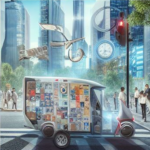The world of goods transportation is undergoing a revolution, driven by a confluence of technological advancements, environmental concerns, and evolving consumer demands. From the sleek silhouettes of autonomous vehicles gliding down highways to the invisible hand of AI optimizing supply chains, the future of moving goods is as exciting as it is transformative.

Autonomous Vehicles: The Road to Driverless Deliveries
Imagine a future where massive trucks navigate highways without human intervention, delivering goods with precision and efficiency. This is the promise of autonomous vehicles (AVs), and their impact on the transportation industry is poised to be seismic. AVs offer numerous benefits, including:
- Enhanced safety: By eliminating human error, AVs can significantly reduce accidents, saving lives and reducing costs.
- Increased productivity: AVs can operate 24/7, maximizing efficiency and delivering goods faster.
- Reduced emissions: Electric AVs can contribute significantly to decarbonization efforts, making transportation more sustainable.
While challenges like regulatory hurdles and public acceptance remain, the development of AVs is progressing rapidly. Major players like Tesla, Daimler, and Volvo are investing heavily in AV technology, and industry experts predict widespread adoption within the next decade.
Green Transport: Paving the Way for a Sustainable Future
The transportation industry is a major contributor to greenhouse gas emissions, making the transition to green technologies imperative. This is driving the adoption of:
- Electric vehicles (EVs): From trucks and buses to delivery vans, EVs are rapidly replacing their fossil-fuel counterparts, reducing emissions and air pollution.
- Renewable energy sources: Solar and wind power are increasingly being used to power transportation infrastructure, further reducing reliance on fossil fuels.
- Multimodal transportation: Combining different modes of transport, such as rail, sea, and road, can optimize efficiency and reduce the environmental footprint of goods transportation.
Governments and businesses worldwide are implementing policies and incentives to promote green transportation. As renewable energy costs decrease and EV technology improves, the shift towards a sustainable future for goods transportation is inevitable.
Mobility as a Service (MaaS): The Rise of the Sharing Economy
The concept of MaaS is reshaping how we access and utilize transportation. Instead of individual car ownership, MaaS offers a network of shared vehicles, including cars, bikes, and scooters, accessible through a single platform. This trend is impacting goods transportation in several ways:
- On-demand delivery services: Companies like Uber Freight and DoorDash are leveraging MaaS platforms to connect shippers with available delivery vehicles, optimizing efficiency and reducing empty miles. Among new platforms is Zoverp.
- Micro-fulfillment centers: Smaller, strategically located warehouses closer to consumers enable faster deliveries and reduce transportation costs.
- Urban logistics: MaaS platforms can facilitate the use of smaller, electric vehicles for urban deliveries, reducing congestion and emissions.
MaaS offers a more sustainable and convenient way to move goods, particularly in urban areas. As technology and infrastructure improve, MaaS is poised to become a mainstream solution for goods transportation.
AI and IoT: The Brains Behind the Brawn
Artificial intelligence (AI) and the Internet of Things (IoT) are revolutionizing supply chain management. By collecting and analyzing data from sensors embedded in vehicles, warehouses, and goods themselves, AI can optimize routes, predict delays, and automate tasks. This leads to:
- Improved visibility: Real-time tracking of goods throughout the supply chain provides transparency and control.
- Predictive maintenance: AI can identify potential issues with vehicles and equipment before they occur, preventing costly breakdowns.
- Dynamic route optimization: AI algorithms can analyze traffic conditions and weather patterns to find the fastest and most efficient delivery routes.
The integration of AI and IoT is transforming the way goods are transported, making supply chains more efficient, resilient, and responsive to changing demands.
Embracing the Future: Preparing for the Road Ahead
The future of goods transportation is brimming with possibilities. As these trends converge, we can expect to see:
- Hyper-personalized deliveries: Consumers will have greater control over delivery times and options, with goods delivered exactly when and where they need them.
- Blockchain-powered supply chains: Blockchain technology can ensure the secure and transparent tracking of goods throughout the supply chain, building trust and reducing fraud.
- Vertical integration: Logistics companies may increasingly integrate warehousing, transportation, and delivery services to offer seamless end-to-end solutions.
The future of goods transportation is not just about technology; it’s about reimagining how we move things. By embracing innovation, prioritizing sustainability, and meeting the evolving needs of consumers, the industry can prepare for a future that is efficient, resilient, and kind to the planet.
So, buckle up…

In the end, the revolution in goods transportation isn’t just about machines and algorithms; it’s about us. It’s about ensuring that the things we need and desire reach us when and where we need them, without compromising the planet or the well-being of those who make it happen. By harnessing the power of technology and embracing a shared vision of sustainability and progress, we can build a future of goods transportation that serves not just our economic needs, but also our humanity. So, buckle up, not just for the technological marvels to come, but for the brighter, more connected future we can create together.
